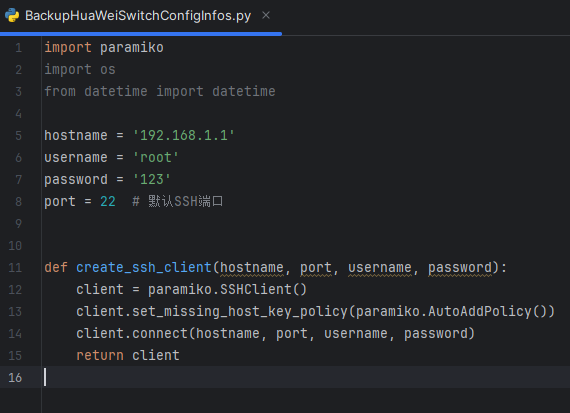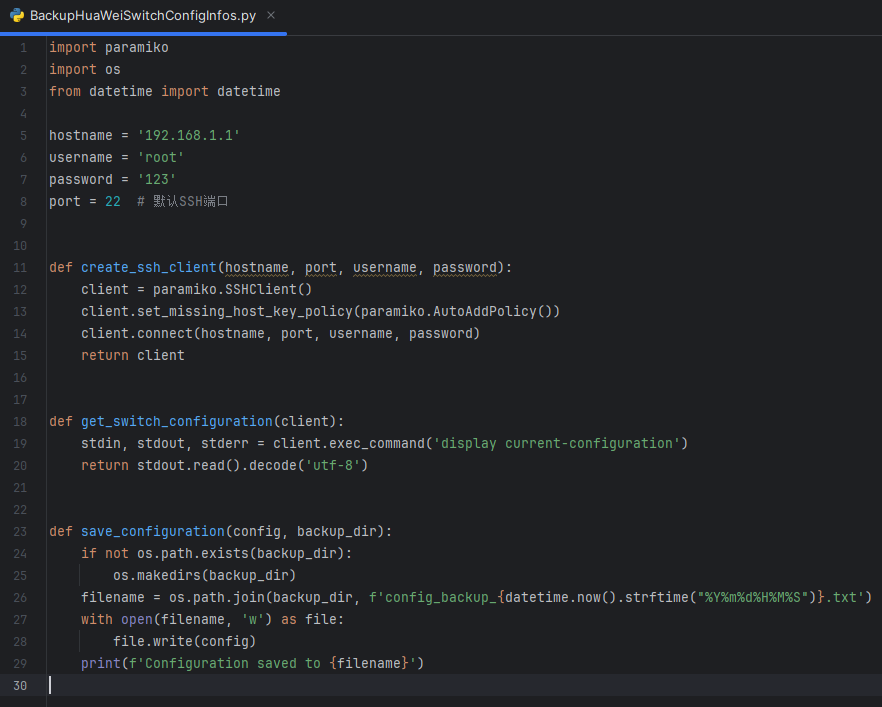

使用Python脚本备份华为交换机的配置信息
描述
转载请注明以下内容:
来源:公众号【网络技术干货圈】
作者:圈圈
ID:wljsghq
在现代网络管理中,备份交换机的配置信息是一项至关重要的任务。备份可以确保在交换机发生故障或配置错误时,能够迅速恢复到之前的工作状态。本文将详细介绍如何使用Python脚本备份华为交换机的配置信息。
在开始编写Python脚本之前,我们需要准备以下环境:
Python环境:确保系统已经安装了Python 3.x。如果没有,可以从Python官方网站https://www.python.org下载并安装。
Paramiko库:这是一个用于SSH连接的Python库。可以使用以下命令安装:
pip install paramiko

华为交换机:本文假设你已经有一台华为交换机,并且可以通过SSH进行访问。
交换机配置文件的存储位置:一个可以存储备份文件的目录。
备份华为交换机配置文件的基本步骤如下:
通过SSH连接到交换机。
执行相应的命令获取配置文件。
将配置文件保存到本地。
编写Python脚本
接下来,我们将详细编写一个Python脚本来实现上述步骤。
导入必要的库
首先,我们需要导入必要的Python库:
import paramiko import os from datetime import datetime

配置连接信息
我们需要配置SSH连接的信息,包括交换机的IP地址、用户名和密码等:
hostname = '交换机的IP地址' username = '用户名' password = '密码' port = 22 # 默认SSH端口

创建SSH连接
使用Paramiko库创建SSH连接:
def create_ssh_client(hostname, port, username, password): client = paramiko.SSHClient() client.set_missing_host_key_policy(paramiko.AutoAddPolicy()) client.connect(hostname, port, username, password) return client

获取交换机配置
连接成功后,我们需要执行交换机的命令来获取配置文件。华为交换机常用的命令是display current-configuration。
def get_switch_configuration(client):
stdin, stdout, stderr = client.exec_command('display current-configuration')
return stdout.read().decode('utf-8')

保存配置文件
我们需要将获取到的配置文件保存到本地。为了便于管理,通常会按照日期命名备份文件。
def save_configuration(config, backup_dir):
if not os.path.exists(backup_dir):
os.makedirs(backup_dir)
filename = os.path.join(backup_dir, f'config_backup_{datetime.now().strftime("%Y%m%d%H%M%S")}.txt')
with open(filename, 'w') as file:
file.write(config)
print(f'Configuration saved to {filename}')

完整的Python脚本
将上述步骤整合成一个完整的Python脚本:
import paramiko
import os
from datetime import datetime
# 配置信息
hostname = '交换机的IP地址'
username = '用户名'
password = '密码'
port = 22 # 默认SSH端口
backup_dir = '备份文件存储目录'
# 创建SSH连接
def create_ssh_client(hostname, port, username, password):
client = paramiko.SSHClient()
client.set_missing_host_key_policy(paramiko.AutoAddPolicy())
client.connect(hostname, port, username, password)
return client
# 获取交换机配置
def get_switch_configuration(client):
stdin, stdout, stderr = client.exec_command('display current-configuration')
return stdout.read().decode('utf-8')
# 保存配置文件
def save_configuration(config, backup_dir):
if not os.path.exists(backup_dir):
os.makedirs(backup_dir)
filename = os.path.join(backup_dir, f'config_backup_{datetime.now().strftime("%Y%m%d%H%M%S")}.txt')
with open(filename, 'w') as file:
file.write(config)
print(f'Configuration saved to {filename}')
# 主函数
def main():
try:
client = create_ssh_client(hostname, port, username, password)
config = get_switch_configuration(client)
save_configuration(config, backup_dir)
except Exception as e:
print(f'An error occurred: {e}')
finally:
client.close()
if __name__ == "__main__":
main()
脚本的执行与验证
修改脚本配置:在脚本中填入实际的交换机IP地址、用户名、密码和备份文件存储目录。
运行脚本:在终端或命令提示符中运行脚本:
python backup_huawei_switch.py
验证结果:检查备份目录,确认配置文件是否正确保存。
脚本的优化与扩展
增加日志记录:可以添加日志功能,记录每次备份的详细信息。
import logging
logging.basicConfig(filename='backup.log', level=logging.INFO, format='%(asctime)s - %(message)s')
def save_configuration(config, backup_dir):
if not os.path.exists(backup_dir):
os.makedirs(backup_dir)
filename = os.path.join(backup_dir, f'config_backup_{datetime.now().strftime("%Y%m%d%H%M%S")}.txt')
with open(filename, 'w') as file:
file.write(config)
logging.info(f'Configuration saved to {filename}')
print(f'Configuration saved to {filename}')
增加错误处理:增强错误处理,确保在连接失败或命令执行失败时能够适当处理。
def main():
try:
client = create_ssh_client(hostname, port, username, password)
config = get_switch_configuration(client)
save_configuration(config, backup_dir)
except paramiko.AuthenticationException:
print('Authentication failed, please verify your credentials')
except paramiko.SSHException as sshException:
print(f'Unable to establish SSH connection: {sshException}')
except Exception as e:
print(f'An error occurred: {e}')
finally:
client.close()
定时任务:可以将脚本设置为定时任务,定期自动备份配置文件。
在Linux上,可以使用cron定时任务:
crontab -e
添加如下任务,每天凌晨2点执行备份:
0 2 * * * /usr/bin/python3 /path/to/backup_huawei_switch.py
在Windows上,可以使用任务计划程序(Task Scheduler)。
-
利用Python脚本登录到交换机并创建VLAN2024-08-12 1408
-
使用python批量备份华为交换机配置文件2024-01-19 2942
-
华为交换机如何批量清除接口配置信息2023-08-14 4259
-
华为三层交换机配置实例2023-06-05 2729
-
交换机最基本的配置与使用方法2023-05-04 3169
-
如何通过Python脚本批量采集华为交换机配置2023-01-09 6597
-
交换机的6种配置模式2022-09-26 11026
-
光纤交换机的种类_光纤交换机的配置2020-11-30 2752
-
华为交换机2017-03-24 2062
-
交换机GMRP配置2016-12-27 1228
-
华为路由器交换机VLAN配置实例2009-05-25 35526
全部0条评论

快来发表一下你的评论吧 !

